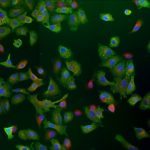Link to Pubmed [PMID] – 15290389
Arch. Virol. 2004 Aug;149(8):1663-71
Interactions of the hemagglutinin (HA) of influenza viruses with sialic acids (SA) are important for host range restriction. Most human H3s have a Ser193, while avian and equine H3s usually have an Asn or a Lys, respectively. To investigate the role of residue 193 in the recognition of SA, substitutions were introduced by mutagenesis within a human H3 and an equine H3. Hemadsorption assays performed on COS-1 cells expressing wt or mutated HAs, showed that a K193S substitution in the context of an equine H3 decreased its ability to bind several animal erythrocytes. Using de- and then alpha2,3 or alpha2,6 re-sialylated chicken erythrocytes we showed that for both human and equine H3s, substitution of a Serine by positively-charged Arginine or Lysine at position 193 increased binding to its preferred receptor, SAalpha2,6Gal and SAalpha2,3Gal, respectively. Moreover, when combined with the L194I substitution, the S193R substitution induced binding of the human H3 to NeuAcalpha2,3Gal.

